
Alaska Department of Health & Social Services Weekly Case Update
November 21 — November 27, 2021
|
Intermediate
Statewide transmission
Rt0.85
|
HIGH
Statewide alert status 268.6
|
LIMITED
Hospital capacity
|
HIGH
Test positivity
5.89%
|
61%
of Alaskans aged 5+ are vaccinated
|
|
Red- Rt >1.2
Orange- Rt 1-1.2 Yellow- Rt <1
|
7-day case rate per 100,000 population.
Red- ≥100
Orange- 50-99.99
Yellow- 10-49.99
Blue- 0-9.99
|
Multiple facilities continue to have a high number of inpatients, which results in delays in admitting patients from emergency departments as well as other operational challenges.
|
Red->5%
Orange- 2-5%
Yellow- <2%
|
This includes people with at least one dose. Estimated AK population 5 and older of 680,580 from the AK Department of Labor & Workforce Development.
|
Case Trends
- Alaska currently has the twenty-fifth highest number of cases in the last seven days per 100,000 population among the 50 states.
- Hospital capacity has been strained during the Delta variant wave of COVID-19 such that in some hospitals, it may become difficult to care for everyone who needs care, even for non-COVID health concerns. Some care may need to be delayed, there may be long wait times, and hospital beds may not be available.
- Hospitalizations are continuing to occur in younger Alaskans, with the median age of persons hospitalized due to COVID-19 in 2021 being about 5 years younger than in 2020.
- Among those hospitalized due to COVID-19 and with specimen collection dates from January 16, 2021 through November 27, 2021, unvaccinated and partially vaccinated patients had a median age 14 years younger than fully vaccinated patients.
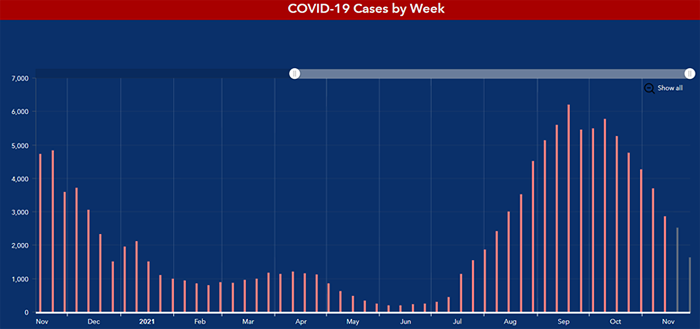
- High levels of COVID-19 transmission are occurring throughout much of Alaska.
- 2,003 cases were reported in Alaskans the week of November 21–November 27. This is a 25.8% decrease from the number of cases reported the week before and indicates a downward trajectory. However, the Thanksgiving holiday likely reduced the amount of testing, so the extent of the downward trajectory may appear larger than it actually was. The course of the COVID-19 pandemic is difficult to predict, and the pattern of declining cases may not be sustained in future weeks.
- In the four largest boroughs (Anchorage Municipality, Matanuska-Susitna Borough, Fairbanks North Star Borough, and Kenai Peninsula Borough), the number of new COVID-19 cases each week appears to be declining. It’s unclear if there’s an upwards or downwards trajectory in Juneau.
- Regardless of the trajectories, high levels of community transmission are widespread and causing significant illness, death, and demand on the health care system.
- The 7-day test positivity rate in Alaska has declined since mid-October, but it remains elevated, and testing continues to be important.
- The intensity of COVID-19 transmission varies substantially between communities outside the largest boroughs. COVID-19 cases are regularly reported from nearly all boroughs and census areas and some communities are experiencing extremely widespread transmission.
COVID-19 Guidance
Take action now to help slow the spread of COVID-19 and preserve health care capacity.
- Please get vaccinated if you haven’t already and get a booster dose if you are eligible (see below for more information). Currently available COVID vaccines will help protect you, your family, and your community against COVID-19, including the Delta variant.
- Wearing a mask when in indoor public spaces regardless of vaccination status is an important step to take to slow the spread of COVID-19. Most Alaskans live in an area with substantial or high community transmission where this action is needed to protect your health and the health of others.
- Continue to avoid crowds and practice social distancing – particularly when indoors.
- Seek testing if you have any symptoms or have been exposed to an infected person. If you do test positive, isolate right away, and notify your contacts. Ask them to get tested and, if they are unvaccinated, to quarantine.
- If you test positive and you’re at increased risk for severe COVID, obtain monoclonal antibody treatment. This has been shown to be an effective treatment for reducing the risk of hospitalization. This treatment works best when given early.
- Persons at high risk include but are not limited to persons who are elderly, immunocompromised, obese, pregnant, or have certain chronic underlying medical conditions.
Borough/Census Area Alert Level Trends
- Alert levels are based on the case counts over the past 7 days as well as the daily number of reported cases over the past 7 days per 100,000 population.
- Alert levels have been changed to more closely mirror CDC’s community transmission indicator and are calculated by borough and census area, rather than by region.
|
Borough/Census Area
|
Alert Level
November 8
|
Alert Level
November 15
|
Alert Level
November 22
|
Alert Level
November 29
|
|
Count
|
Rate
|
Count
|
Rate
|
Count
|
Rate
|
Count
|
Rate
|
|
Anchorage Municipality
|
1,401
|
484.8
|
904
|
312.8
|
793
|
274.4
|
652
|
225.6
|
|
Fairbanks North Star Borough
|
515
|
530.1
|
294
|
302.6
|
289
|
297.5
|
211
|
217.2
|
|
Juneau City and Borough
|
75
|
236.0
|
31
|
97.6
|
49
|
154.2
|
60
|
188.8
|
|
Kenai Peninsula Borough
|
275
|
466.6
|
155
|
263.0
|
158
|
268.1
|
99
|
168.0
|
|
Matanuska-Susitna Region
|
694
|
646.8
|
537
|
500.4
|
407
|
379.3
|
340
|
316.9
|
|
Nome Census Area
|
231
|
2,364.6
|
170
|
1,740.2
|
112
|
1,146.5
|
80
|
818.9
|
|
North Slope Borough
|
53
|
542.4
|
31
|
317.3
|
54
|
552.7
|
35
|
358.2
|
|
Northwest Arctic Borough
|
114
|
1,503.4
|
118
|
1,556.1
|
103
|
1,358.3
|
70
|
923.1
|
|
Chugach Census Area
|
24
|
355.5
|
17
|
251.8*
|
24
|
355.5
|
10
|
148.1*
|
|
Copper River Census Area
|
22
|
815.1
|
23
|
852.2
|
25
|
926.3
|
22
|
815.1
|
|
Denali Borough
|
11
|
609.1*
|
4
|
**
|
7
|
387.6*
|
0
|
**
|
|
Southeast Fairbanks Census Area
|
42
|
605.4
|
30
|
432.5
|
9
|
129.7*
|
19
|
273.9*
|
|
Yukon-Koyukuk Census Area
|
36
|
713.7
|
18
|
356.9*
|
13
|
257.7*
|
8
|
158.6*
|
|
Haines Borough
|
4
|
**
|
2
|
**
|
1
|
**
|
1
|
**
|
|
Petersburg Borough
|
49
|
1,536.5
|
43
|
1,348.4
|
76
|
2,383.2
|
38
|
1,191.6
|
|
Sitka City and Borough
|
7
|
82.1*
|
6
|
70.4*
|
10
|
117.3*
|
8
|
93.9*
|
|
Skagway Municipality
|
1
|
**
|
0
|
**
|
0
|
**
|
0
|
**
|
|
Wrangell City and Borough
|
8
|
336.3*
|
28
|
1,177.0
|
21
|
882.7
|
10
|
420.3*
|
|
Yakutat plus Hoonah-Angoon
|
7
|
264.4*
|
2
|
**
|
9
|
339.9*
|
3
|
**
|
|
Ketchikan Gateway Borough
|
49
|
358.3
|
89
|
650.7
|
91
|
665.4
|
91
|
665.4
|
|
Prince of Wales-Hyder Census Area
|
30
|
492.6
|
32
|
525.5
|
24
|
394.1
|
3
|
**
|
|
Bethel Census Area
|
224
|
1,253.6
|
188
|
1,052.2
|
204
|
1,141.7
|
129
|
722.0
|
|
Kusilvak Census Area
|
45
|
556.4
|
32
|
395.6
|
37
|
457.5
|
41
|
506.9
|
|
Aleutians East Borough
|
6
|
205.1*
|
2
|
**
|
2
|
**
|
2
|
**
|
|
Aleutians West Census Area
|
4
|
**
|
0
|
**
|
2
|
**
|
4
|
**
|
|
Dillingham Census Area
|
10
|
209.5*
|
14
|
293.3*
|
13
|
272.4*
|
9
|
188.6*
|
|
Kodiak Island Borough
|
47
|
372.7
|
35
|
277.5
|
16
|
126.9*
|
9
|
71.4*
|
|
Bristol Bay plus Lake and Peninsula
|
13
|
537.2*
|
13
|
537.2*
|
10
|
413.2*
|
4
|
**
|
|
Statewide
|
3,997
|
548.4
|
2,818
|
386.6
|
2,559
|
351.1
|
1,958
|
268.6
|
*Rates based on <20 observations are statistically unreliable and should be used with caution.
**Rates based on <6 observations are not reported.
Vaccination Status
- Anyone aged ≥5 years in Alaska is now eligible to receive a COVID-19 vaccine.
- If you have received an initial dose of the Pfizer or Moderna COVID-19 vaccine, be sure to get your second dose too.
- Everyone ≥18 years old who received the primary series of an mRNA (Pfizer or Moderna) COVID-19 vaccine ≥6 months ago is now eligible for a booster dose.
- In particular, persons aged ≥50 years and persons aged 18+ who live in long-term care settings should receive a booster dose.
- For people who received the Janssen (Johnson & Johnson) COVID-19 vaccine, a booster dose (either the Janssen vaccine again or an mRNA vaccine) is recommended for anyone aged ≥18 years who was vaccinated ≥2 months ago.
- Learn more about who should get a booster dose and to find COVID-19 vaccines near you at covidvax.alaska.gov.
- CDC recommends that people with moderately to severely compromised immune systems receive an additional dose of mRNA COVID-19 vaccine at least 28 days after a second dose of an mRNA vaccine.
- Vaccinated persons with immunocompromising conditions should discuss with their health care providers the need for additional personal protective measures.
- To schedule your vaccine appointment visit covidvax.alaska.gov or call 907-646-3322.
- To find clinics in your area you can visit vaccines.gov or text your zip code to GETVAX (438829) in English, or VACUNA (822862) for Spanish.
- The Alaska vaccine dashboard is available online for the most up-to-date data.
Borough/Census Area Vaccination Coverage
This is the percent of Alaskans aged ≥5 years who received one or more doses of vaccine.
|
Borough/Census Area
|
November 29
|
|
Aleutians East Borough
|
94%
|
|
Aleutians West Census Area
|
72%
|
|
Anchorage Municipality
|
66%
|
|
Bethel Census Area
|
77%
|
|
Bristol Bay plus Lake and Peninsula
|
75%
|
|
Denali Borough
|
75%
|
|
Dillingham Census Area
|
61%
|
|
Fairbanks North Star Borough
|
53%
|
|
Haines Borough
|
71%
|
|
Juneau City and Borough
|
81%
|
|
Kenai Peninsula Borough
|
50%
|
|
Ketchikan Gateway Borough
|
68%
|
|
Kodiak Island Borough
|
70%
|
|
Kusilvak Census Area
|
79%
|
|
Matanuska-Susitna Borough
|
44%
|
|
Nome Census Area
|
80%
|
|
North Slope Borough
|
41%
|
|
Northwest Arctic Borough
|
64%
|
|
Petersburg Borough
|
67%
|
|
Prince of Wales-Hyder Census Area
|
68%
|
|
Sitka City and Borough
|
80%
|
|
Skagway Municipality
|
79%
|
|
Southeast Fairbanks Census Area
|
38%
|
|
Valdez-Cordova Census Area
|
64%
|
|
Wrangell City and Borough
|
64%
|
|
Yakutat plus Hoonah-Angoon
|
78%
|
|
Yukon-Koyukuk Census Area
|
80%
|
|
Statewide
|
61%
|
New Hospitalizations and Deaths
- Cumulative hospitalizations increased by 52 to 3,053. Hospitalization reports often lag when a case was initially reported.
- 8.7% of hospitalized patients in Alaska had COVID-19 as of November 30, 2021.
- On November 27th there were 80 persons with COVID-19 in AK hospitals, which is a 22.3% decrease relative to the week before when there were 103 persons hospitalized.
- The cumulative number of COVID-19 deaths among Alaska residents increased by 16 to 848. It is common to take some time for a death to be reported and verified, and deaths that occurred during November 21–November 27 may be reported in the future after death certificates are reviewed.
Total Confirmed COVID Beds Occupied
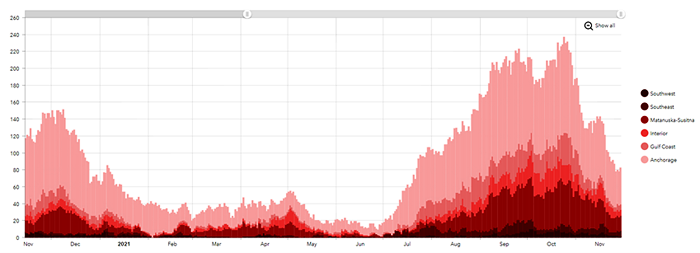
Variant Tracking
The most recent Genomic Surveillance data can be found on the “COVID-19 Variants” tab of the Cases Dashboard.
|
Variants of Concern
|
Cases Identified
|
Change from Previous Report
|
First Identified in Alaska
|
|
Delta (B.1.617.2-like)
|
5,595
|
+252
|
30 May 2021
|
|
|
|
Variants Being Monitored
|
Cases Identified
|
Change from Previous Report
|
First Identified in Alaska
|
|
Alpha (B.1.1.7)
|
463
|
0
|
20 December 2020
|
|
Beta (B.1.351)
|
7
|
0
|
20 March 2021
|
|
Epsilon (B.1.427/429)
|
138
|
0
|
24 December 2020
|
|
Eta (B.1.525)
|
1
|
0
|
16 March 2021
|
|
Gamma (P.1/P.1.1/P.1.2)
|
76
|
+1
|
8 February 2021
|
|
Iota (B.1.526)
|
24
|
0
|
4 February 2021
|
|
Mu (B.1.621)
|
161
|
0
|
6 May 2021
|
|
Zeta (P.2)
|
4
|
0
|
27 January 2021
|
Vaccine Breakthrough Cases
- Vaccine breakthrough (VB) infections of COVID-19 are those detected in a person who is at least 2 weeks beyond their second dose of a 2-dose series or the only dose of a 1-dose series.
- Alaska residents who are fully vaccinated are much less likely to be hospitalized due to COVID-19 than those who are not fully vaccinated. (Age-standardized per capita rates of COVID-19 hospitalizations by vaccination status are updated monthly.)

- The following updated VB data are among Alaska residents aged ≥12 years with a specimen collection date from January 16–November 27, 2021. (Children ages 5 to 11 are not included because at this time they have not been eligible for vaccination long enough to become fully vaccinated.)
- From January 16–November 27, 2021, 100 deaths, 300 hospitalizations, and 23,729 cases with a VB infection were reported among Alaska residents aged ≥12 years. These counts are provisional and subject to change as data are compiled and reviewed. In that same time frame, a total of 78,298 cases, 1,873 hospitalizations, and 540 deaths were reported.
- 70% of all cases, 84% of all hospitalizations, and 81% of deaths among Alaska residents aged ≥12 years from January 16–November 27, 2021 were in people who were not fully vaccinated.
- More detailed information about hospitalizations, deaths, repeat and vaccine breakthrough infections among Alaska residents can also be found in the monthly report, which has been updated to include data through October.
- Age-standardized per capita rates of COVID-19 cases by vaccination status are updated weekly. Some COVID-19 cases with specimen collection in the immediate past week (indicated by the grey box) may have not yet been reported or counted.
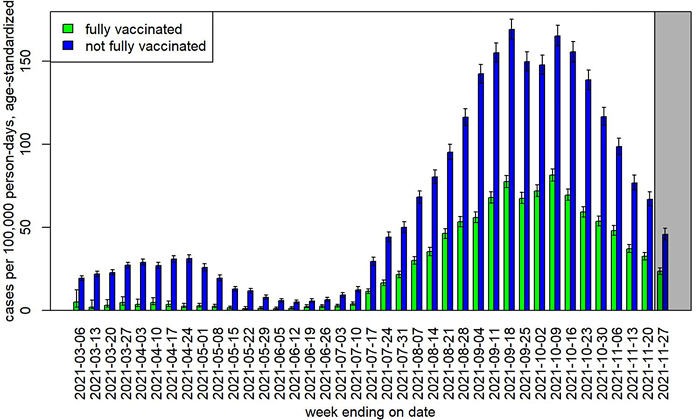
- The following table shows by region the number of vaccine breakthrough cases, the number of cases among persons aged ≥12 years who are not fully vaccinated, and the number of cases among children 11 years and younger who are not fully vaccinated. (Children 5 to 11 years old have not been eligible for vaccination long enough to be considered fully vaccinated).
| |
Cases (November 21–November 27)
|
|
Region
|
Vaccine breakthrough
(≥12 years)
|
Not fully vaccinated
(≥12 years old)
|
Not fully vaccinated
(<12 years old)
|
|
Anchorage Municipality
|
228
|
256
|
128
|
|
Fairbanks North Star Borough
|
45
|
60
|
17
|
|
Juneau City and Borough
|
22
|
20
|
12
|
|
Kenai Peninsula Borough
|
22
|
45
|
9
|
|
Matanuska-Susitna Borough
|
53
|
195
|
40
|
|
Northwest Region
|
83
|
40
|
45
|
|
Other Interior Region
|
14
|
22
|
6
|
|
Other Southeast Region - Northern
|
20
|
27
|
5
|
|
Other Southeast Region - Southern
|
26
|
42
|
12
|
|
Southwest Region
|
**
|
**
|
**
|
|
Y-K Delta Region
|
70
|
37
|
57
|
**To protect privacy, data are excluded from rows in which any value is <5.
- A variety of factors may affect the proportion of vaccine breakthrough cases by region. In communities with higher vaccination coverage, a larger proportion of cases is expected to occur among fully vaccinated persons. Other potential factors include the extent of prior infection in a region and differences in testing practices between regions.
COVID-19 Communication Resources
Statewide Percentage of Daily Tests with Positive Results
(Seven day rolling average)
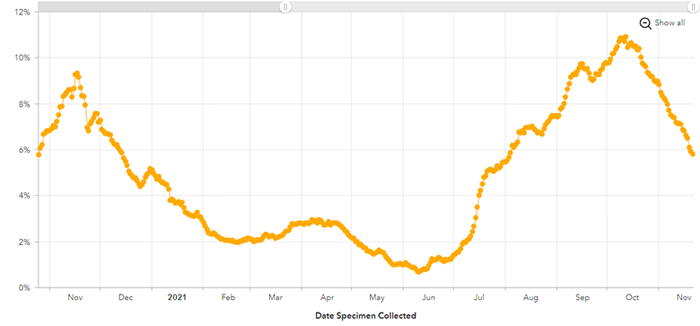
Cases by Week of Onset and Age
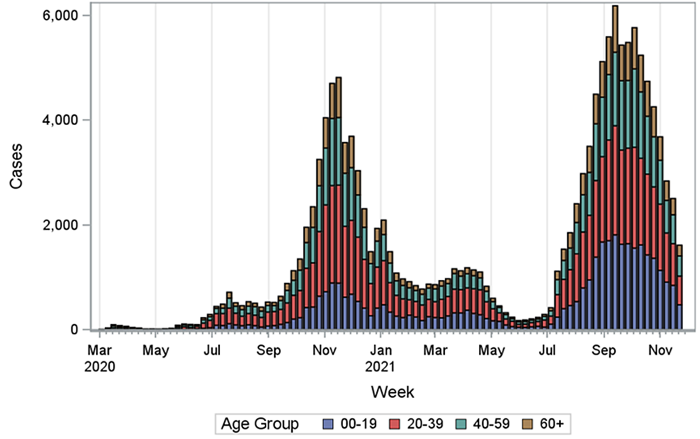
Note: Quality assurance efforts are ongoing to attribute cases to the correct date on the onset date epi curve. Some recent cases will be reattributed to different weeks.
Cases by Week of Onset and Race

Note: Quality assurance efforts are ongoing to attribute cases to the correct date on the onset date epi curve. Some recent cases will be reattributed to different weeks. Race abbreviations include AI/AN (American Indian or Alaska Native), Asian/NHOPI (Asian, Native Hawaiian or Other Pacific Islander), and UI/Unknown (Under investigation or unknown).
Additional informational resources:
Additional ECHO session details:
These ECHO sessions are produced and facilitated by UAA’s Center for Human Development Alaska ECHO project in partnership with the State of Alaska, Department of Health & Social Services

|
Important Note: Most Division of Public Health ECHO series will be taking a break from December 20-December 31 for the winter holidays. Please check individual ECHO registration pages for additional information on holiday scheduling.
Our upcoming Palliative Care ECHO will focus on POLST in anticipation of Alaska’s transition from Comfort One to POLST in 2022. During our session participants will have an opportunity to hear from guest speakers who will share their experiences and knowledge of implementing a state-wide POLST program, and be available to answer questions.
Cindy Bruzzese, MPA, MSB, HEC-C, Executive Director & Clinical Ethicist at the Vermont Ethics Network, will present a didactic on their state's roll out and approach to state-wide education, and Sharmon Figenshaw, ARNP ACHPN and Hillary Walker, OTL, will provide case presentations.
Series to highlight:
Palliative Care ECHO: Implementing a State-Wide POLST Program
Tuesday Dec. 7th 12-1 p.m.
Our upcoming Palliative Care ECHO will focus on POLST in anticipation of Alaska’s transition from Comfort One to POLST in 2022. During our session participants will have an opportunity to hear from guest speakers who will share their experiences and knowledge of implementing a state-wide POLST program, and be available to answer questions.
Cindy Bruzzese, MPA, MSB, HEC-C, Executive Director & Clinical Ethicist at the Vermont Ethics Network, will present a didactic on their state's roll out and approach to state-wide education, and Sharmon Figenshaw, ARNP ACHPN and Hillary Walker, OTL, will provide case presentations.
Alaska Medical Provider ECHO: Long COVID
Tuesday Dec 7th 7-8:15 p.m
Please join us for a special ECHO session focusing on Long COVID, featuring a presentation by our guest expert Greg Vanichkachorn, M.D., M.P.H., medical director of the Mayo Clinic COVID Activity Rehabilitation Program. Dr. Vanichkachorn will provide an overview of Long COVID and how post-COVID symptoms impact patients, and will be available to answer questions during the Q&A portion of our session.
Regular Series
Alaska Medical Provider ECHO (formerly COVID-19 for AK Healthcare Providers)
Monthly on the 1st Tuesday of the month from 7-8 pm
This ECHO aims to increase knowledge and share best practices among medical providers across Alaska as well as to increase access to information for those living in rural areas of the state.
School Health ECHO
Every Monday from 3:00-4:00 p.m. Register
The School Health ECHO is a virtual learning network intended for professionals in the education setting (administrators, school-based nurses, etc.) to interface with a team of medical and education experts in Alaska.
Vaccine ECHO for Providers
Weekly on Tuesday from 2-3 p.m. Register
The Vaccine ECHO for providers provides planning and operation updates to vaccine providers across Alaska, while answering any questions you may have.
Palliative Care ECHO
Monthly on the first Tuesday from 12-1 p.m.
This monthly ECHO is for all Alaskan healthcare disciplines supporting patients with serious illness, and aims to provide support and up-to-date information regarding Palliative Care during this period of COVID-19. Our next session will include a didactic presentation Meeting People Where They Are: Providing Palliative Care to Rural Populations by guest presenter Nancy Joiner APRN, ACHPN from the University of North Dakota’s Center for Rural Health.
Public Science ECHO
Weekly on Wednesday from 12-1 p.m. register via Zoom
The Alaska Public Health Science ECHO is a virtual learning network intended for the general public to interface with our Public Health Leadership Team to explore the science of the COVID-19 virus, other public health topics, and current best practices. Or view via concurrent livestream to Facebook: https://www.facebook.com/akechoprograms
Local Government Public Health ECHO
Monthly on the third Wednesday from 3-4 p.m. Register
The Local Government Public Health Analysis ECHO is a virtual learning environment intended for local Alaska government leaders to interact with the State Public Health Leadership team and focuses on pandemic mitigation tools available, and how to use them.
Long Term Care Facilities ECHO
Second Wednesday of the month from 4-5 p.m. Register
Please join other staff and administrators of Alaska’s assisted living homes and residential care facilities to gather, learn, share, and grow. COVID has disrupted the fabric of our daily life and we can always learn from each other as we adjust to the new normal.
Healthcare Specific Situational Awareness ECHO
Weekly on Thursday from 12-1 p.m. Register
The Healthcare Specific Situational ECHO is a virtual learning network intended for healthcare professionals to interface with our Public Health Leadership Team to explore current best practices and the most recent information related to Public Health.
Perinatal ECHO
Monthly on 3rd Thursday from 6-7 p.m. Register
The Alaska Perinatal ECHO is a virtual learning network intended for medical providers caring for pregnant patients and their newborns.
EMS ECHO
Monthly on the 1st and 3rd Wednesday 1-2 p.m Register
The EMS ECHO is a virtual learning network intended for Emergency Medical Services and related personnel in Alaska to amplify best practices. Sessions are topic-driven and typically include a guest presenter or a brief lecture with an interactive case or process discussion.
Co-Occurring Behavioral Health, Opioid and Stimulant Use Disorders ECHO Returning with new didactics!
1st & 3rd Wednesdays from 12:00pm-1:00pm, November 3, 2021 - April 20, 2022
The Co-Occurring Behavioral Health (COBH), Opioid and Stimulant Use Disorders ECHO facilitates a virtual network for behavioral health providers to learn best practice care through real-time access to experienced subject matter experts and their peers. Each session includes a brief lecture, de-identified case presentation for participants to receive feedback on complex cases, and open discussion facilitated by an interdisciplinary team.
Data Waivers ECHO New ECHO!
2nd Wednesdays from 12:00pm-1:00pm, November 10, 2021 - September 14, 2022
The Data Waivers ECHO facilitates a virtual network for clinical providers to learn and implement best practices for offering buprenorphine and other medically assisted treatment (MAT) services under a data waiver. Each session includes a brief lecture, de-identified case presentation for participants to receive feedback on complex cases, and open discussion facilitated by an interdisciplinary team.
Session information and recordings of previous ECHO sessions
subscribe to ECHO calendar updates | email: echo@alaskachd.org | website: akecho.org
|
|









